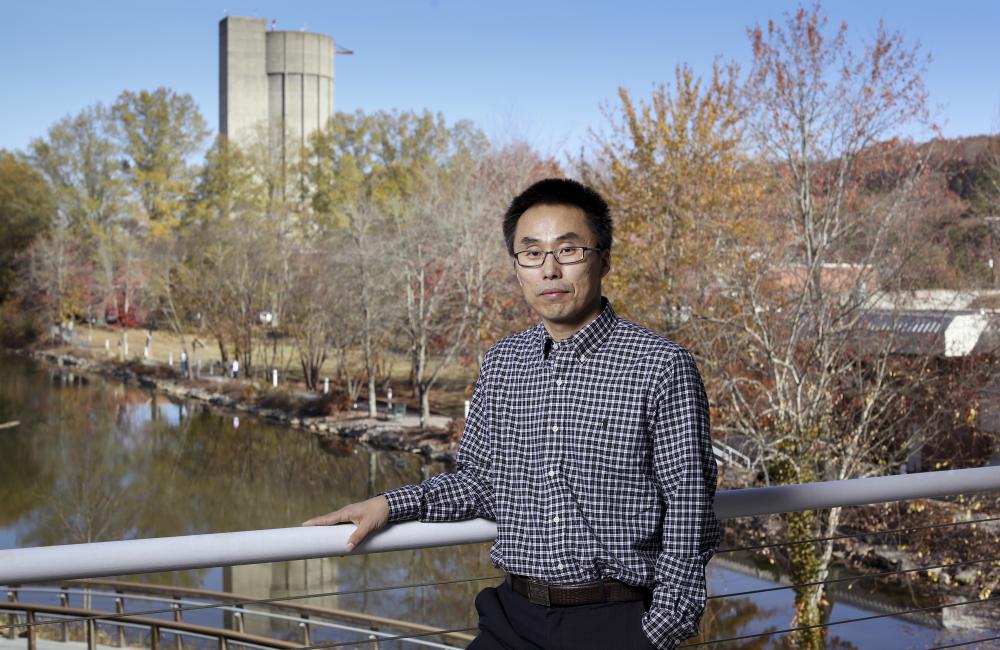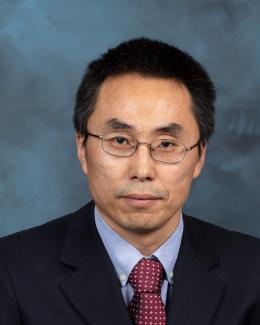January 19, 2017 – Kai Xiao's work as a staff scientist at ORNL’s Center for Nanophase Materials Science gives him access to some of the world’s most powerful tools to investigate materials as small as one-billionth of a meter, or at the nanoscale.
He joins multidisciplinary teams to explore a variety of materials that exhibit exotic optical and electronic properties and functions – such as conducting polymers, hybrid perovskites and two-dimensional crystals – that could be applied in energy-related devices.
One of Xiao’s research thrusts involves photovoltaics, or solar cells, an increasingly popular renewable energy source whose acceptance is nevertheless hindered by high production costs. Kai would like to change that.
“My biggest motivation is seeking materials for low-cost thin film solar cells that are highly efficient and long-lasting,” he said.
Replacing costly inorganic-based materials with a wide choice of organic materials or hybrid inorganic-organic perovskites would yield a less expensive material that can be scaled up for roll-to-toll fabrication of flexible modules with many different shapes, colors and transparencies while maintaining comparable energy efficiency.
Chemistry has been Xiao’s focus since he entered East China Institute of Technology in his native China. His fascination grew as he was drawn to chemical experiments that synthesized new materials. In 1998, he completed his bachelor’s degree and received a master’s in material science and engineering from the Chinese Academy of Science’s Institute of Metal Research in 2001.
As Xiao entered the doctoral program at the Chinese Academy’s Institute of Chemistry, his interest in research began to take shape under the guidance of his adviser, Dr. Yunqi Liu.
“He is a very smart and diligent person and a dear friend with whom I still enjoy exciting discussions during our visits,” Xiao said.
“We generally understand that polymers can be used to make plastic bottles, chairs and tires,” Xiao said. “But, how is it possible those polymers can be made to behave like silicon and apply them to electronic devices?” Under Liu’s guidance, Xiao was inspired to learn more.
After graduation, Xiao canvassed the world for options to continue his postdoc research. The United States, and specifically ORNL, was his choice. He was impressed by the lab’s world-class research facilities and its many famous scientists, namely Clifford Shull, Stephen J. Pennycook and Douglas H. Lowndes. He was also attracted by the beauty of the East Tennessee region.
In 2004, Xiao joined ORNL as the first postdoctoral researcher hired at the CNMS, a DOE User Facility that opened in 2005, later becoming a staff scientist in 2008 in Dave Geohegan’s Optical Interactions group at CNMS. Since then, he has established synthesis and processing facilities at CNMS to move novel materials all the way to functional working prototype devices and understand their properties by involving theory and modeling, in collaboration with Bobby Sumpter and his group.
“I really enjoy working with the overall, fantastic work teams at the CNMS,” Xiao said. “The management team and my coworkers truly care about me and my career goals and are willing to help me achieve them, especially Dave and Bobby.”
Xiao leads the effort at the CNMS focused on exploring the functional processing and optoelectronic properties of hybrid perovskites, conducting polymers and atomically thin, two-dimensional materials – that is, materials that are just a few atoms to one atom thick. This research track has resulted in an impressive string of high-profile journal articles over the past several years.
Currently, Xiao and his team strive to understand the practical application of atomically thin 2-D crystals by finding ways to wire up actual prototype devices with novel structures. They’re on the forefront of semiconducting 2-D materials ushering in the future of electronics.
Xiao shares his findings beyond scientific journals. In 2011, he became a joint faculty member of the University of Tennessee’s Bredesen Center for Interdisciplinary Research and Graduate Education and the Department of Electrical Engineering and Computer Sciences.
“ORNL provides a good balance between the freedom to do academic research and opportunities to work on projects that are applied, relevant and useful to society,” he said.
ORNL is managed by UT-Battelle for the Department of Energy's Office of Science, the single largest supporter of basic research in the physical sciences in the United States. DOE’s Office of Science is working to address some of the most pressing challenges of our time. For more information, please visit energy.gov/science. – By Sara Shoemaker




